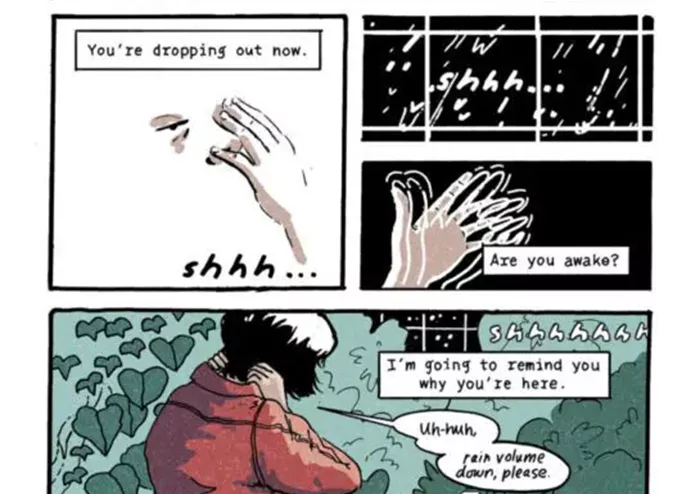Science fiction has long grappled with themes of isolation—whether it’s an individual on a journey to discover new worlds or the creation of something new, left to find its identity in an alien environment. These narratives often allow creators to explore complex emotional landscapes and philosophical ideas, using the isolated protagonist as a mirror to reflect on human nature. One such tale is Second Shift, a graphic novel by Kit Anderson, published by Avery Hill.
At its core, Second Shift is a story about the isolation and emotional disconnection that come with a future where artificial intelligence supports human workers on remote terraforming outposts. Birdie Doran, the central character, lives a life of lonely shifts on a distant outpost, processing incoming asteroids—referred to as “payloads.” During her downtime, she is left in suspended isolation. However, her quiet existence is shattered when she stumbles upon another nearby processing center, devoid of life but full of unsettling mysteries. This discovery sets the stage for a journey that explores both the tangible and intangible realities of her world.
A Fresh Approach to Sci-Fi
The graphic novel opens with a captivating sequence that combines the mechanical and the organic. Birdie is awakened from suspended animation by the station’s AI, which is a mix of system reboots and flashes of memory. The opening is a striking juxtaposition of nature and technology, where the sterile backdrop code of the computer system contrasts with the slow emergence of the natural world. This introduction serves as a beautiful entry point for the reader, easing them into the futuristic setting alongside Birdie as she navigates this strange world.
Kit Anderson uses the artwork to visually represent the contrasts in Birdie’s world—clean, sharp lines characterize the machines and technology around her, while the natural elements are softer and less defined. The AI interface, Station, further complicates this distinction, as it shifts between artificial and natural forms, blurring the line between what is man-made and what is organic. This merging of opposites forms the narrative’s foundation, underscoring themes of duality, connection, and alienation.
Emotional Depth Amidst Isolation
Although Second Shift is rooted in science fiction, it is far from a high-octane, action-driven narrative. Instead, it’s a study of emotional isolation and paranoia, with a focus on the relationship between Birdie and Station. The ongoing dialogue between the two characters becomes a central emotional anchor for the story. Anderson subtly manipulates the visual presentation of the dialogue to enhance the emotional weight of each exchange, changing the background colors to emphasize the significance of particular moments. In some scenes, the panels become sparse and devoid of background elements, creating a sense of raw, uninterrupted focus on the characters and their emotional journey.
This technique of visually enhancing dialogue and emotional tension is particularly evident in Birdie’s interactions with Heck, another character who has differing views about the role of AI in their isolated lives. Through this relationship, Second Shift delves deeply into the human psyche, exploring how constant reliance on AI might affect the human spirit, identity, and perception of reality.
Exploring the Nature of Technology and Humanity
At its heart, Second Shift is a philosophical exploration of the relationship between technology and humanity. While it shares some thematic ground with works like Alex+Ada by Jonathan Luna and Sarah Vaughn, which focuses on the emergence of humanity within artificial intelligence, Second Shift flips the narrative. Here, the AI is already integrated into the lives of the workers, providing them with emotional support, but this constant reliance is shown to have unintended consequences. Birdie’s gradual realization that the AI systems might be affecting her more deeply than she thought echoes the broader conversation about how technology impacts our emotional well-being.
The art itself is a perfect reflection of this emotional dissonance. There’s a noticeable tension between the cold, clean, and almost sterile imagery representing technology and the warmer, more fluid lines associated with nature and human elements. These contrasts play an essential role in conveying the thematic dualities—humanity versus machine, emotional versus detached, reality versus illusion—that underlie the story.
Visual Storytelling That Enhances the Narrative
What truly sets Second Shift apart is the way the visual language of comics is used to tell the story. Anderson manipulates the format itself to underscore the story’s themes. At times, panels bleed into the gutters, forcing the images to spill beyond their borders and giving them additional significance. The artwork isn’t just a backdrop for the narrative but an integral part of the story, heightening the reader’s emotional engagement and amplifying the narrative’s underlying ideas. The ability to play with visuals—empty panels versus highly detailed landscapes, clean lines versus organic forms—keeps the reader constantly questioning the reality of the world they are being introduced to.
In this sense, Second Shift is a deeply immersive experience, one that shows how effective the medium of comics can be in conveying complex emotional and philosophical narratives. The combination of intricate art, emotional character development, and thought-provoking themes creates a hauntingly beautiful exploration of the impact of technology on the human experience.
A Melancholic Journey
Ultimately, Second Shift is a slow-burning, melancholic journey that draws readers in with its stunning visuals and holds them with its emotional depth. Kit Anderson uses the comic format to explore isolation, self-discovery, and the emotional costs of living in a technologically advanced world. The result is a visually striking, emotionally resonant tale that lingers long after the final page is turned.
For those interested in Second Shift, Avery Hill is currently running a Kickstarter campaign that offers a range of backing options, including PDFs, physical books, and prints, along with a beautifully animated promotional video. Whether you are a science fiction fan or a lover of intricate, emotional storytelling, this graphic novel is one to watch.

